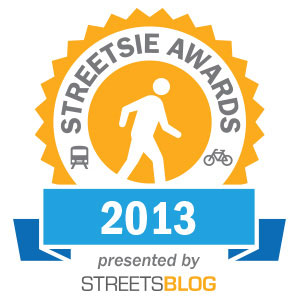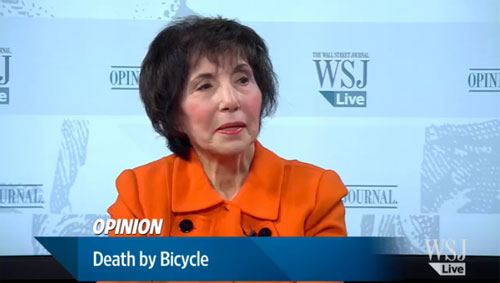The 2013 NYC Streetsies, Part 1
12:49 AM EST on December 30, 2013
The Streetsie votes are in and it's time to hand out virtual hardware. But first, a friendly reminder that Streetsblog needs your support.
Reader donations are what Streetsblog runs on. Contribute to our year-end pledge drive and you'll help produce reporting and commentary that makes a difference, so that when this time rolls around next year, we'll be doling out a new batch of Streetsies to projects as deserving as this year's winners. All contributions to Streetsblog NYC before the new year will be matched by an anonymous donor, up to $10,000, and if you give $50 or more, you'll be entered to win a new PUBLIC C7 or V7 bicycle. We've also got a new Nutcase helmet to give away to one lucky donor. So don't put off that contribution any longer -- it's time to give.
And now, the first round of the 2013 NYC Streetsies...
Best Victory
For five years we’ve been asking readers to choose the most important achievement in livable streets, and nothing has run away with the vote quite like Citi Bike. The launch of the nation’s largest bike-share system was a huge success and a fitting capstone to NYC DOT’s run of innovation under Mayor Michael Bloomberg and Transportation Commissioner Janette Sadik-Khan.
The numbers are compelling. With daily trips peaking above 42,000, New Yorkers are getting about as much as we can out of a network with 300 or so stations and around 5,700 bikes. Subscriptions have been on sale for a little more than eight months, and already there are nearly 100,000 annual members. That’s a lot of people using public bikes to go across town, connect to the subway, ride to work, or run errands – all on a system delivered at minimal public expense.

While its utility alone would be enough to nab this Streetsie, the bike-share launch has special significance for reasons that are tougher to quantify.
To start with, the astonishing growth in ridership (after a few weeks, the system was already getting as much or more use than London’s after a few years) showed the huge latent demand for cycling in New York. Just by making it more convenient, Citi Bike enticed tens of thousands of people to get around town on a bicycle.
And thanks to bike-share, the boundary between “cyclists” and “not-cyclists” looks a lot blurrier today. To bicycle in New York City, you no longer have to own a bike and keep it in working condition. Anyone with a credit card can ride a public bike if they think it’s going to be worth their while, just like they can take the subway or hail a cab.
If you rode Citi Bikes during the heady first two weeks, you probably experienced one of those moments when a total stranger peppered you with questions at a kiosk, a cabbie rolled down his window and gave you a thumbs up, or someone on the sidewalk shouted “How does it ride?” as you rolled past with a big smile on your face. Sure, some of the chattiness was due to the sheer newness of the bikes and the stations, but it also reflected a change in public perception. Bicycling for transportation had become something we can all do.
Look at the bike-share coverage from April or May, and it feels like a different era. Remember this Ginia Bellafante gem about the ugly stations that will help New Yorkers "show the world that they are just as virtuous, well-intentioned and offended by sloth as people in Copenhagen or Geneva"? Hard to believe the Times published it a mere eight months ago. And that was nothing compared to the stream of stories in the Post about how bike-share would kill people.
Let’s hope all that content never disappears from the internet. With bike-share having quickly established itself as a widely-used, well-regarded addition to NYC’s transportation network, the archive of complaints and alarmism preceding the Citi Bike launch is going to be an invaluable reference for livable streets advocacy. If a future mayor wavers about reforming the status quo on the streets, all those irrational stories about bike-share should be a great spine-stiffener. Citi Bike is proof that mayors can pull off ambitious livable streets projects that disrupt some people’s habits -- yes, even their parking habits -- and come out ahead politically.
Citi Bike does have its flaws, chief among them a software/hardware platform that remains troublingly inefficient for the operator to run and more unreliable for users than it should be. Additionally, while programs are in place to help unbanked New Yorkers join the system, these initiatives don’t appear to be sufficient to make Citi Bike broadly appealing to people who lack access to credit. These are problems that need to get fixed in order for bike-share to grow and serve as many people as it can.
With so many people already relying on Citi Bike, it’s probably only a matter of time before the system is improved and expanded. Bike-share works great in New York City, and it’s just begun to change the way we get around.
Best Pedestrian Safety Project
A 2003 rezoning has transformed Fourth Avenue in Park Slope from a strip of auto body shops, tire suppliers, lube joints, and drive-thrus into a thickly-settled street. But the street design -- skinny pedestrian medians sandwiched between six lanes of traffic -- was stuck in the past until this year. For taming one of Brooklyn’s most notorious speedways with a mix of wider medians, narrower rights of way for motor vehicles, and turn restrictions, the Fourth Avenue road diet earned the Streetsie for Best Pedestrian Safety Project.

Credit for this one is shared by NYC DOT, the neighborhood residents and volunteers who pushed for a better Fourth Avenue, and City Council members Brad Lander and Steve Levin, who made sure that the project moved forward quickly after Community Board 6 balked at the redesign.
Best Bike Lane Project
NYC DOT expanded the bike network in 2013 with a mix of new lanes in neighborhoods where bike infrastructure is scarce and upgrades and extensions to existing bike routes. The runner-up for Best Bike Lane Project brought bike lanes to a part of the city that had none: Now Brownsville has painted bike lanes and sharrows on New Lots Avenue, Pitkin Avenue, Mother Gaston Boulevard, Hendrix Street, and Schenck Avenue. With an array of community groups contributing to a neighborhood bike plan for Brownsville and East New York, there should be more bike lanes on the way.
The winner had a bit of everything: The First Avenue protected bike lane in East Harlem and the Upper East Side was a huge upgrade over the old, rutted un-protected bike lane. It pairs up with the Second Avenue protected bike lane to create a safe, north-south bicycling option above 100th Street. And it links to the Willis Avenue Bridge for an excellent interborough connection with the Bronx (as long as NYPD isn't staking out the bridge handing out bogus tickets). All in all, a great NYC DOT project and a testament to local advocates and Council Member Melissa Mark-Viverito, who worked hard to make it happen.

Best Bus Project
The two Select Bus Service routes that launched in 2013 are improving reliability and speeding up trips for tens of thousands of daily passengers on Webster Avenue in the Bronx and Nostrand Avenue in Brooklyn. But it's tough for an improvement to a single bus route to compete against something that makes every route in an entire borough more predictable and convenient. Blanketing Manhattan with real-time bus tracking picks up this Streetsie.
Best Plaza Project
With NYC DOT's plaza program continuing to roll out new public spaces neighborhood by neighborhood, it's hard to set one above the rest. The top two vote getters did have something in common, though. Marcy Plaza in Bed Stuy and Willoughby Plaza in Downtown Brooklyn are both built out of concrete -- they feel more permanent than a quick resurfacing.
Willoughby Plaza might have picked up the most votes because it carries extra symbolic weight. Originally reclaimed for use by people in 2006, it was the first of the current generation of DOT pedestrian plaza projects, and this year became the first to get upgraded with permanent materials.
Best Use of a Pedestrian Plaza
Eschewing the usual fluorescent-lit room, Council Member Danny Dromm held a Community Board 3 meeting in Jackson Heights' Diversity Plaza. The community board process has never been so transparent. Maybe we should start calling them "agoras" instead of plazas.

Favorite Streetfilm
Nothing beats a romp with Clarence through a city that's really figured out this whole livable streets thing. Streetfilms' tour of Groningen showed us, in Clarence's words, "Candyland, but for bikes" -- a city center where people come first and "cars seem extinct."
Best Trend
The New York State Department of Motor Vehicles and NYPD both stopped using the word "accident" to describe traffic crashes. Then San Francisco got in on the action, officially making it a trend.
Best Dorothy Rabinowitz Catchphrase
You can make an argument that Wall Street Journal editorial board member Dorothy Rabinowitz did more for bike advocacy this year than anyone else. Overnight, her viral video appearance, "Death by Bicycle," made it weird and fringy to oppose bike-share. When she proclaimed, "The bike lobby is an all-powerful enterprise," you had to laugh at the derangement. Unhinged as it was, you also had to read it as a strange form of acknowledgement. Ideas that bike advocates have circulated for a generation are turning into real policy and infrastructure. The movement for safer biking in NYC is no all-powerful enterprise, but it is an increasingly influential constituency.
Best Non-Rabinowitz Artifact of the Bike-share Launch Period
What will the New Yorkers of 2050 make of Jacques Capsouto, the restaurateur so convinced a bike-share station would hurt his business that he sat down by the gutter and blocked its installation?
Best Report
NYC DOT ended 2013 with a great triptych of reports. "Sustainable Streets: 2013 and Beyond" was a comprehensive overview of the accomplishments of the last six years. "Making Safer Streets" was a user-friendly guide to how the department approaches street redesigns to reduce traffic injuries. The best, though, was "The Economic Benefits of Sustainable Streets" -- which created a brand new methodology to answer the age-old question of how street redesigns affect local businesses.
Best Cause for Optimism Heading Into 2014
The City Council’s Progressive Caucus has a great transportation platform, its leaders appear to have secured top posts in the next term -- including the speakership -- and they're tight with the new mayor.
Stay in touch
Sign up for our free newsletter
More from Streetsblog New York City
Report: Road Violence Hits Record in First Quarter of 2024
Sixty people died in the first three months of the year, 50 percent more than the first quarter of 2018, which was the safest opening three months of any Vision Zero year.
Street Sweepers Could Nab Illegal Parking Under State Bill
Smile for the street-sweeper!
Thursday’s Headlines: The Way of Water Edition
The "Blue Highways" campaign wants the mayor to convert a downtown heliport into a freight delivery hub. Plus more news.
Gotcha-Heimer! Anti-Congestion Pricing Jersey Rep. With a City Speeding Ticket Drove to Manhattan on Wednesday
New Jersey's most vociferous opponent of congestion pricing parked illegally and once got a speeding ticket.






